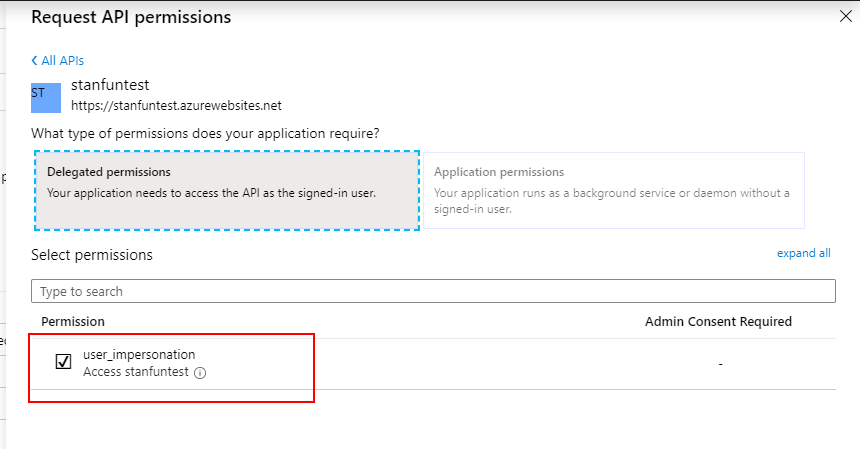解答:对于寻找此答案的任何人,我可以通过在 MSAL acquireToken 调用范围内指定 Web API 来获取所需的 token ,如下所示:
let token = msal.acquireToken({
scopes: [ 'myFunctionApp.azurewebsites.net/user_impersonation' ]
})
完成此操作后,我将该 token 用作身份验证 header 中的承载 token 。除了调用 MS Graph 端点之外,我还可以使用它。我在一个安静的偏僻地方找到了此信息:
非常感谢@StanleyGong 的帮助,最终找到了答案。
/////
过去几天我一直在寻找如何有效地保护从调用 Azure Function App 的 Azure Web 应用程序提供的 Vue SPA。我为 Web 应用程序和函数应用程序打开了 Easy Auth,并且我正在调用 /.auth/me 端点来获取 id token ,我读过该 token 可以用作不记名 token 。所以我正在做的是调用 /.auth/me 并使用返回的 id_token 创建授权 header ,但我仍然得到 401 Unauthorized 调用函数 app 时。
从/.auth/me 获取 id_token 并将其作为默认 header 添加到所有 Axios 调用的代码(我确实认识到这需要刷新...我将在获得后创建所有逻辑一次调用即可工作):
let authUrl = '/.auth/me';
let response = await axios.get(authUrl);
let token = response.data[0].id_token;
axios.defaults.headers.common['Authorization'] = "Bearer " + token;
我可以看到请求中的授权 header 中使用了 token ,该 header 紧接在上面的部分之后:
Accept-Encoding: gzip, deflate, br
Accept-Language: en-US,en;q=0.9
Authorization: Bearer eyJ0eXAiO...
我看到了这篇文章并尝试使用其中的一些信息,包括 Chris Gillum 的博客文章(这很有帮助,但仍然没有让我到达那里):Authentication for Azure Functions
关于如何让它发挥作用有什么建议吗?我觉得我已经很接近了,但我还没有完全做到这一点。如果这不是正确的方法,任何建议也会有所帮助。
总的来说,我在身份方面缺乏经验,所以我一直在使用术语,而文档中的不一致并没有帮助我。
此外,有没有什么方法可以测试这些东西,而无需在每次更改时部署代码?通过以某种方式从商店获取 token 而无需将代码放在网络应用程序服务器上来测试这一点会很棒......我猜这是一厢情愿的想法,但只是想知道。
编辑:我刚刚意识到我读过的所有帖子都表明访问 token 是从 /.auth/me 返回的,但我没有得到。返回的 JSON 看起来像这样,这就是全部:
id_token: "eyJ0eXA...7_A"
provider_name: "aad"
user_claims: [{typ: "aud", val: "2...fa"},…]
user_id: "<<my email address>>"
另一个编辑:我发现我可以使用 MSAL 获取 token ,但它包含的信息与 /.auth/me 中的信息略有不同。使用任一 token 作为不记名 token 仍然会导致 401。我确实注意到,在应用程序的 AAD 身份验证设置中,颁发者 URL 不同。一个是 sts.windows.net,另一个是 login.windows.net。两人身上都贴有租户 ID。不确定这是否会产生影响,但我尝试将它们设置为相同的值,但这没有帮助。
/.auth/me token (当然已清理):
{
"aud": "2fe...fa", (AAD app id)
"iss": "https://sts.windows.net/<< AD tenant id >>/",
"iat": 15785xxx,
"nbf": 15785xxx,
"exp": 15785xxx,
"aio": "AVQAq/...UQ=",
"amr": [
"pwd",
"mfa"
],
"family_name": "<< my last name >>",
"given_name": "<< my first name >>",
"ipaddr": "<< my ip >>",
"name": "<< my full name >>",
"nonce": "e32a...48",
"oid": "a0...0e",
"sub": "LNu...8l8",
"tid": "f14...2ca",
"unique_name": "<< my email >>",
"upn": "<< my email >>",
"uti": "i9O...TAQ",
"ver": "1.0"
}
MSAL 访问 token :
{
"aud": "000...000", (mostly 0s...not sure what this id is)
"iss": "https://sts.windows.net/<< AD tenant id >>",
"iat": 15785xxx,
"nbf": 15785xxx,
"exp": 15785xxx,
"acct": 0,
"acr": "1",
"aio": "AVQAq/8O...ZZ12s=", (different than above)
"amr": [
"pwd",
"mfa"
],
"app_displayname": "<< app name in AAD app registration >>",
"appid": "<< app GUID from AAD >>",
"appidacr": "0",
"family_name": "<< my last name >>",
"given_name": "<< my first name >>",
"ipaddr": "<< my ip >>",
"name": "<< my full name >>",
"oid": "a0...0e", (same as above)
"platf": "3",
"puid": "10...1B",
"scp": "User.Read profile openid email",
"signin_state": [
"kmsi"
],
"sub": "WuX...L3A",
"tid": "f14...2ca", (tenant id, same as above)
"unique_name": "<< my email >>",
"upn": "<< my email >>",
"uti": "UD...AA",
"ver": "1.0",
"xms_st": {
"sub": "LNu...8l8"
},
"xms_tcdt": 14...37
}
最佳答案
对于您的方案,您可以在租户中注册 Azure AD native 应用程序作为客户端,以获取 access_token 作为承载 token 来调用您的 Azure 函数。如果您使用服务到服务调用,只需引用my previous post here 。
如果您要登录用户,您还应该使用其他配置在您的租户中注册 Azure AD 应用程序:
 向此应用程序添加 user_impersonation 权限,以便用户可以登录您的应用程序并调用您的 Azure 函数(请在此处记下您的 azure 函数应用程序 ID,我们稍后将使用它):
向此应用程序添加 user_impersonation 权限,以便用户可以登录您的应用程序并调用您的 Azure 函数(请在此处记下您的 azure 函数应用程序 ID,我们稍后将使用它):
 添加此权限并授予它:
添加此权限并授予它:


完成这些步骤后,您的新应用程序将能够登录用户来调用您的 Azure 函数。
我不确定你的VUE应用程序代码是什么样的,但这是一个VUE adal sample我的演示将基于它。
1.下载代码并前往src/main.js将其内容替换为以下代码:
import Vue from 'vue'
import axios from 'axios'
import { default as Adal, AxiosAuthHttp } from 'vue-adal'
import App from './App.vue'
import router from './router'
Vue.config.productionTip = false
const functionBase = `<your Azure function URL>`
const functionResource = '<your Azure function application ID>'
Vue.use(Adal, {
config: {
tenant: '<your tenant ID>',
clientId: '<your new resistered app ID>',
redirectUri: '<redirect url you mapped in your new resgistered app ID, in this case it should be : http://localhost:8080>',
cacheLocation: 'localStorage'
},
requireAuthOnInitialize: true,
router: router
})
Vue.use({
install (vue, opts = {}) {
// Configures an axios http client with a interceptor to auto-acquire tokens
vue.prototype.$functionApi = AxiosAuthHttp.createNewClient({
// Required Params
axios: axios,
resourceId: functionResource, // Resource id to get a token against
// Optional Params
router: router, // Enables a router hook to auto-acquire a token for the specific resource
baseUrl: functionBase, // Base url to configure the client with
onTokenSuccess (http, context, token) { // Token success hook
// When an attempt to retrieve a token is successful, this will get called.
// This enables modification of the client after a successful call.
if (context.user) {
// Setup the client to talk with the Microsoft Graph API
http.defaults.baseURL = `${functionBase}`
console.log(token)
}
},
onTokenFailure (error) { // Token failure hook
// When an attempt to retrieve a token is not successful, this will get called.
console.log(error)
}
})
}
})
new Vue({
router,
render: h => h(App)
}).$mount('#app')
2.
前往src/views/Home.vue ,替换<script>的内容代码部分如下:
<script>
// @ is an alias to /src
import HelloWorld from '@/components/HelloWorld.vue'
export default {
name: 'home',
components: {
HelloWorld
},
data () {
return {
msg: "Signing in..."
}
},
async created () {
if (this.$adal.isAuthenticated()) {
this.msg = "Hello, " + this.$adal.user.profile.name
let functionInfo = await this.getAzureFunctionInfo()
this.msg += " | function result : " + functionInfo
} else {
this.msg = "Please sign in"
}
},
methods: {
async getAzureFunctionInfo () {
let res = await this.$functionApi.get('',{
params: {
'name': 'test'
}
})
console.log(res)
return res.data
}
}
}
</script>
让我们测试一下结果:
由于此项目将在本地运行,您应该转到 Azure 函数 => 平台功能 => 所有设置以启用所有 cors 请求,以便您可以从静态 vue 项目在本地测试您的函数:

我的函数逻辑很简单,如果你用参数调用它,它会回复一个 hello 响应:

运行项目,并通过 url 在私有(private)浏览器窗口中打开它: http://localhost:8080
您将被要求登录,您可以看到它可以成功调用Azure函数:

我认为这就是您正在寻找的答案。
更新:
根据您的代码,您正在使用 Azure AD V2 登录用户,请:
1)按照第二种解决方案重新注册Azure广告应用并完成权限授予过程,以便它可以登录用户并访问您的Azure功能。
2) 在您的 Azure AD 中,找到代表您的 Azure 函数应用程序名称的 Azure AD 应用程序(我的 Azure 函数名称是 :stanfuntest ):
将范围复制到此处:

2)在您的VUE代码中,使用此应用程序ID作为客户端ID来登录用户,修改代码以获取您刚刚找到的范围的访问 token :
let token = msal.acquireToken( { scopes: [ 'https://stanfuntest.azurewebsites.net/user_impersonation' ] } )
希望有帮助。
关于azure - 从静态文件 SPA 调用 Azure Function App,我们在Stack Overflow上找到一个类似的问题: https://stackoverflow.com/questions/59637635/